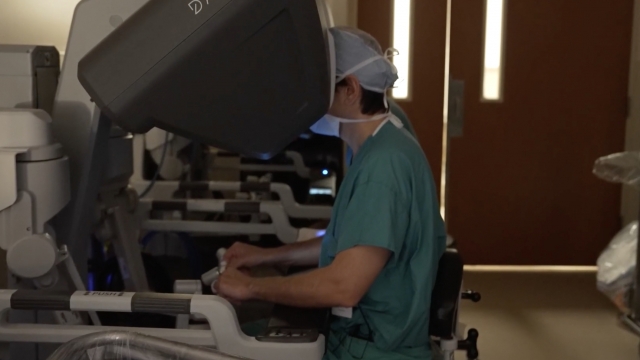The first robotic surgery happened in Belgium in 1997. It was considered an expensive novelty met with skepticism. Fast forward 26 years and now it's a standard of care across many medical specialties. There's also been a proliferation robotic surgery companies.
In heart surgeries doctors are now able to use robot assistance and cameras, to operate without totally opening up a patient's chest.
After placing the devices in small incisions across the chest, the surgeon can perform a range of procedures, looking through an immersive three dimensional viewer and manipulating the tools virtually with the same depth perception as they could with the naked eye.
Computer assisted instruments allow surgeons to operate with precision and stillness in a much smaller space.
The Society of Thoracic Surgeons counts the number of robot-assisted heart surgeries across the U.S. and says while they still account for a small percentage of heart procedures, their use has steadily increased for the last decade and a half — from roughly 0.6% to 1.6%.
Minimally invasive, robot-assisted heart surgeries have advantages, one of the biggest being the rapid patient recovery times compared with those using a conventional sternotomy, when the chest has to be cracked open.
SEE MORE: Upcycled organs and pig hearts: where cardiac transplant is headed
Kathryn Coombs, 67, of Houston, found that part the most attractive. She had been dealing with the effects of hypercardiomyopathy for several years.
"I was more breathless. I couldn't walk as far," Coombs said. She said she loved to garden outside and hoped the expected quicker recovery would enable her to get planting again.
"My garden hasn't had anything in it since 2018," she said.
Her surgery to reduce the damage done by a leaky mitral valve and thickened heart muscle took about 6 hours. It normally would be done through open heart surgery. With those procedures alone, she would be home in three days, because it was minimally invasive, done with the assistance of a DaVinci robot. However, her physicians discovered during her surgery she would need a pacemaker too, so she stayed a full week.
"Currently, the robots serve for us to be able to do the cases and the operations minimally invasive,even more minimally invasive than our previous techniques," said Dr. Danny Ramzy, chief of robotics and heart surgeon at UT Physicians and Memorial Hermann Hospital in Houston.
Ramzy has performed hundreds of procedures and said the machine assistance offers a huge surgical helping hand.
"It provides a magnified view and 3D image. So you're able to perform the surgeries, I would say even better than what you would do in the regular technique," Dr. Ramzy said. "More importantly, it takes away the surgeon's tremors."
Memorial Hermann Hospital gave Scripps News an inside look at Coombs' surgery, which took around 6 hours total. Dr. Ramzy likens the minimally invasive approach to building a model ship in a bottle.
"They're working with these shafted instruments, trying to put the ship together in a bottle through a small incision," Dr. Ramzy said.
SEE MORE: Doctors Optimistic About Medical Breakthroughs For 2023
Critics say the cost of the procedure may be considered a luxury. Some studies suggest it costs $40,000 or higher for use of the robot alone.
But proponents for robot use believe reducing patient time in the hospital and overall recovery time balances out the high-priced high technology.
"We're starting to see those that are being performed totally endoscopic maybe makes a difference where we're not rib spreading, where we're just using small incisions, just using only the ports of the robot to be able to do these procedures. Patients go home, they have less complications, they have less pain and form for the patients," Dr. Ramzy said.
Houston high school teacher and cross country running coach Joseph Christopherson, 30, underwent robotic surgery to solve a myocardial bridge — when arteries normally supposed to lie on the surface of the heart go through the muscle.
"I was in the hospital for, I think it was six days total," he said.
If a surgery is open heart, a patient can be in the hospital a week or longer. The entire healing process takes up to two months because of the opening of the chest.
"The average is about three days in the hospital, but we have a couple of colleagues across the country that have sent patients home the next day," Dr. Ramzy said.
In fact, Dr. Sloan Guy, a heart surgeon who also uses robots in his practice, said one of his patients did just that.
"What you're seeing is a renaissance in robotic surgery," across multiple medical specialties, Dr. Guy said.
Dr. Ramzy and his team gave Scripps News a training demonstration with the DaVinci robots repairing a mock heart valve on a dummy.
Dr. Ramzy said his next challenge and that for doctors like him is training the next generation of heart surgeons to be comfortable and expert with robotics.
"The minimally invasive option and now the robot option has increased the amount of patients we can help," Dr. Ramzy said. "I do see in the future robotics being going down to even better platforms where the robots also can perform some of the task for you."
Trending stories at Scrippsnews.com



